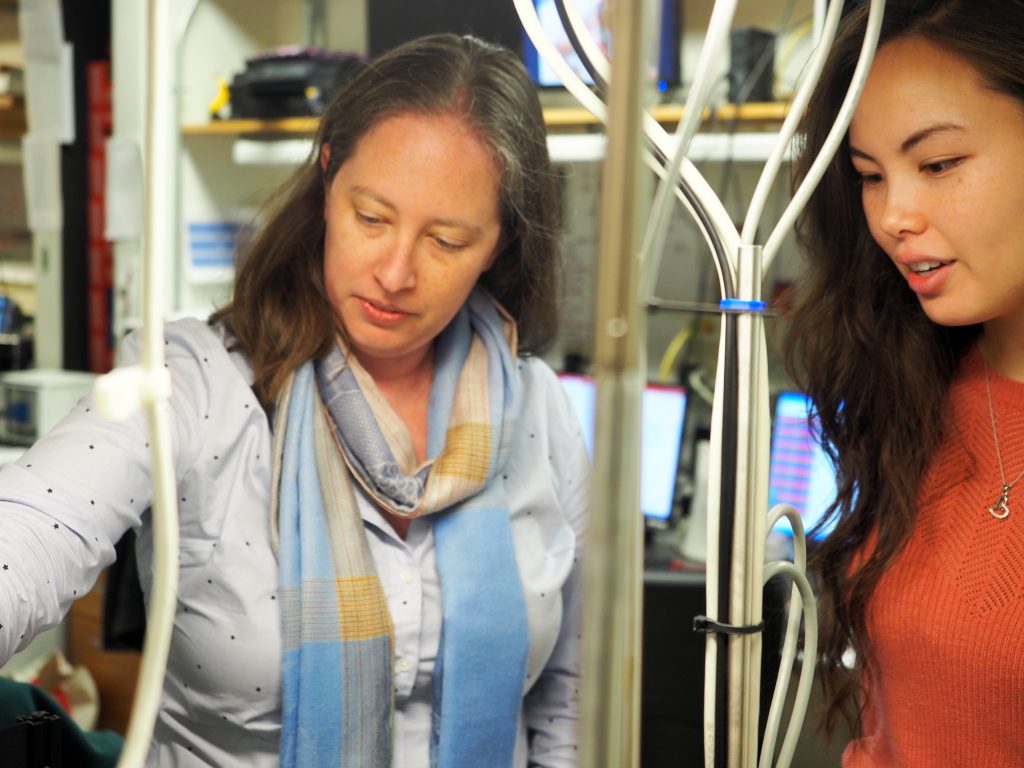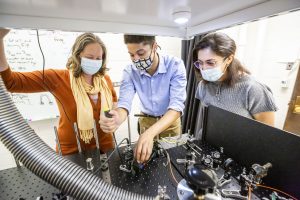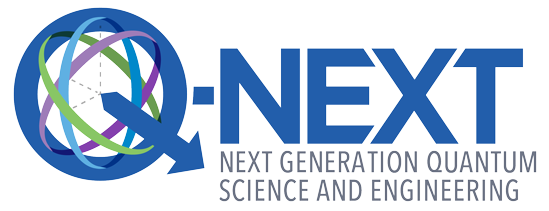There’s more than one way to wrangle a photon.
Every day, people send photons — particles of light — back and forth to communicate. They transmit information encoded as patterns of light, whether turning a radio dial, entering an address into a GPS unit, or sending an email.
But there’s another way to harness light for communication: not by manipulating patterns, but rather by exploiting an individual photon’s innate features, its quantum nature.
By taking advantage of traits that are accessible only at the level of the individual particles, scientists are developing fundamentally new, powerful ways of sending and receiving messages: as quantum communication. The payoff is expected to be next-level: networks that are invulnerable to attack and vastly stronger connections between high-performance computers — this could enable solutions to the world’s most intractable problems.
Researchers such as Elizabeth Goldschmidt, an assistant professor at the University of Illinois at Urbana-Champaign, are developing all manner of maneuvers for managing photons as quantum carriers of information.
“It’s an interesting hard problem, but one that’s really important. The possibilities are massive for quantum communication — potentially world-changing,” said Goldschmidt, a Q-NEXT collaborator who is also a member of the Illinois Quantum Information Science and Technology Center and NSF Hybrid Quantum Architectures and Networks quantum research centers. “But it’s super difficult, a total mess, which is why people are investigating every possible way to do this. We just don’t know what’s going to work best.”
For her part, Goldschmidt is corralling photons into quantum memories.

The fragility of the qubit
A quantum memory is like the memory on your desktop computer. It’s a temporary holding cell that preserves transmitted information until the information is needed later, when the data can be passed down the line.
The information is stored in fundamental units called qubits, analogous to computer bits. Qubits can be encoded in any number of ways, including as atoms, electrons, special circuits — and photons.
A viable quantum memory should be able to hold on to qubits for a relatively long time, a tall order given that quantum information is famously fussy. A qubit’s faintest interactions with its surroundings can extinguish the encoded information.
Add to that the challenges of wrangling photons, the fastest-moving objects in the universe. How do you hold onto them for long enough to be useful? They also get lost easily. How do you compensate for their waywardness? And how do you do all of this in a way that they keep to themselves, without interacting with their environment?
Goldschmidt began confronting the puzzle in her undergraduate days at Harvard University and continues to tackle it as a full-time physicist and professor.
“I really like this problem of getting quantum information back and forth between stuff and light, the quantum light-matter interface,” Goldschmidt said. “We want to do this in a way that can be built and engineered into systems. To do that, I need to somehow find a way to get this photon to some site without losing it, then read it into some system without measuring it, and do that in a way that I can read it back out again at a later time.”
Preserving memories in rare earths
As a part of Q-NEXT, a DOE National Quantum Information Science Research Center led by the U.S. Department of Energy’s Argonne National Laboratory, Goldschmidt investigates rare-earth atoms as quantum memories, vaults of quantum information.
Rare-earth atoms have electron arrangements that make them great for information storage. (See atomic numbers 58 through 71 on the periodic table.) They’re particularly useful as qubit components when embedded inside crystals.
The encoded photons pass into the crystal structure and port their information (thanks to quantum physics’ peculiar features) to the rare-earth atoms. The atoms in turn preserve the information as a particular configuration of electron energy levels. Both the photons and the atoms avoid the kinds of interactions that destroy quantum information, allowing it to be stored and retrieved.

In their quest to make the perfect qubit for storage, Goldschmidt and her team are identifying and growing new crystal-and-rare-earth-atom combinations, tracking how they respond to the passage of photons, assessing their memory-storage capabilities, and improving them.
It’s a finicky task. If the rare-earth atoms in the crystal are positioned too close together, they interfere with each other, disrupting the encoded information. If they’re too far apart, the atoms stretch and strain the crystal differently at each site, disrupting the regularity that’s needed to hold on to quantum information.
“So we’re trying to hit the sweet spot,” Goldschmidt said. “We want to find materials that work well and turn them into a quantum memory with low disorder. That will allow us to make a more compact, longer-lived, more efficient quantum memory than what you can make now.”
Trapped ions for today’s telecommunication
Goldschmidt and her team also work with trapped-ion qubits as part of NSF Hybrid Quantum Architectures and Networks, a National Science Foundation Quantum Leap Challenge Institute.
Ions are atoms that are stripped of one or more electrons. Scientists can use lasers and electrodes to trap the ions — hold them in place — as they float in a vacuum. The ions are encoded with quantum information and coaxed into giving that information up into a photon.
Trapped ions are currently among the leading platforms for quantum computing technologies.
“An atom in vacuum is pretty much a perfect little quantum system. It’s got nice, beautiful, discrete atomic energy levels. It can maintain information for longer because it’s not interacting with its environment,” Goldschmidt said.
But it has its challenges, too. For one, the photon that the trapped ion spits out is the wrong color for today’s fiber-optic networks. Telecommunication devices transmit photons in the infrared spectrum. But the photons emitted by the commonly used ion qubits are typically blue, of shorter wavelength, and blue photons won’t get far in an optical fiber.
“It would be nice if those photons were at the wavelength where light experiences the least loss over optical fiber, and we can use standard optical components,” Goldschmidt said.
She and other HQAN collaborators are developing a way to convert blue photons into red. Their optical system sucks just the right amount of energy from the blue photon, converting it into an infrared photon that’s compatible with today’s telecommunication networks.

The quantum playground
“We really have a playground to work with where we can investigate the drawbacks and benefits of different materials,” Goldschmidt said. “Instead of relying on the materials we know exist, we should continue to try to make new ones, make them better — develop qubits based on what we want, not what we have.”
Playing in the quantum playground takes all kinds, and Goldschmidt’s lab is a mix of electrical engineers, materials scientists, mechanical engineers and physicists.
“We’re really sitting at the border of science and engineering,” Goldschmidt said.
She shares the joy of discovery with her students at the U of I. In addition to teaching 1,000-person intro-to-physics classes, she engages people interested in science through outreach efforts such as the Conference for Undergraduate Women in Physics, hosted by the American Physical Society. This spring she is helping organize a regional meeting to be held at the U of I.
She’s also a member of the Open Quantum Initiative, based at the Chicago Quantum Exchange. The initiative champions diversity, equity and inclusion in quantum science, and Goldschmidt is helping develop its undergraduate fellowship program, which seeks to advance career and research opportunities for members of racial and ethnic groups historically underrepresented in the field of quantum science.
In her lab, Goldschmidt oversees both graduate and undergraduate students. It’s important to get interested students in the lab early, she says. While they’ll learn the equations that describe quantum phenomena in the classroom, there’s no substitute for experimenting in the playground.
“Quantum information, the actual quantum mechanics behind it — writing down these systems is easy,” Goldschmidt said. “When you try to do it in the lab, you discover these new effects. Probing these boundaries where our toy model systems run up against what we actually have in the lab — that’s my favorite thing.”
This work was supported by the DOE Office of Science National Quantum Information Science Research Centers.
